As someone who specializes in SEO for publishers, I spend a lot of time looking at Google News and helping my clients optimize for it. Sometimes my enthusiasm for Google News raises an eyebrow and begs the question:
Why should we spend time focusing on Google News when we get very little traffic from it?
I like when that question comes up because it gives me to the opportunity to explain why you’re probably getting more traffic from Google News than you think, or at least more than what’s being reported by your analytics platform.
Google News can send you huge bursts of visits, but the problem is that the big analytics platforms, like Google Analytics and Adobe Analytics, report Google News visits only as the referrals received from the Google News vertical at news.google.com (or news.url.google.com). While that’s technically correct, there’s a goldmine of other “News” traffic getting lumped in with Google Organic.
The Top Stories News Box
I have a broader definition of Google News. When I think of Google News, I’m thinking not only of the Google News vertical at news.google.com (and accompanying mobile app), I’m thinking of the Top Stories news box that frequently appears in the regular Google organic results. Those look like this:
Top Stories (on desktop)
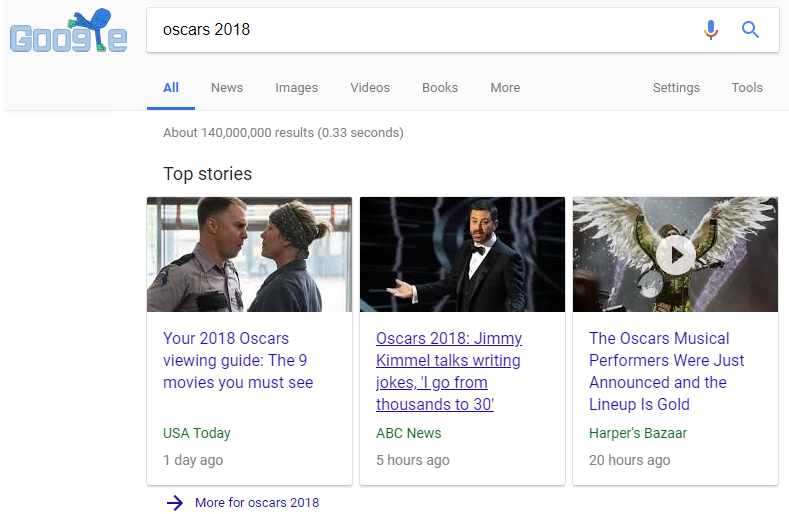
Top Stories (on mobile)

There are also lots of fresh results you’ll see mixed into Google’s main results when Google thinks it makes sense (i.e. query deserves freshness, or QDF). Although those similarly emphasize recency over links, and represent one of the ways your content can appear at the top of Google results minutes after publishing, it would be a stretch to call these News results since they routinely include non-News sites.
But Doesn’t “Top Stories” Contain More Than Just Google News?
Strictly speaking, yes. Top Stories is a feature of Google Search, not Google News. The headlines you see can definitely be pulled from non-Google News sources.
But that hasn’t always been the case. Here’s a so-called “news onebox” from December 2013:
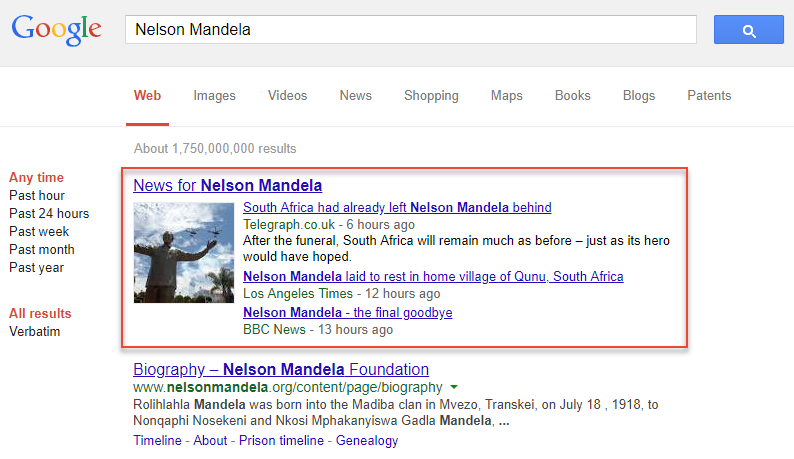
Back then, the news onebox results only included Google News publishers. There were some differences between the headlines listed in the story clusters that appeared in the Google News interface and the news onebox results in Google Search, which seemed to suggest, even then, that the Google News and Google Search teams were doing their own processing on the same data set.
In October 2014, Google changed the label on the news onebox from “News for…” to “In the news,” and confirmed that the newer version was indeed showing content from non-news sites, like Reddit.
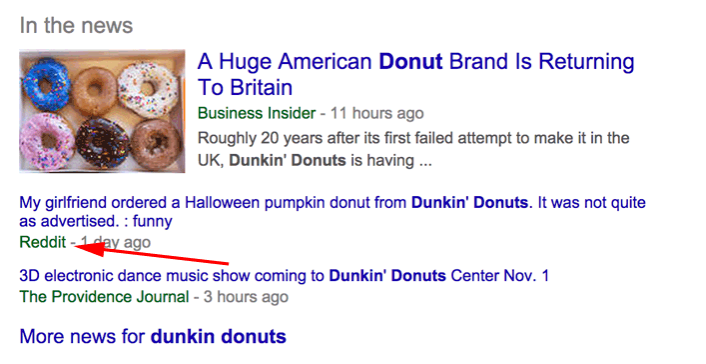
Finally, at the end of 2016, Google changed from “In the news” to “Top stories,” in an effort to better align desktop results with mobile results.
So Top Stories can definitely show headlines from non- Google News sources, but that’s not typically what you’ll see.
Top Stories Are (Still) Mostly Google News Results
Anyone who spends much time looking at Top Stories boxes can tell you, at least anecdotally, that the headlines in those features are mostly from Google News sites.
In fact, News Dashboard did an analysis showing that “99.31 percent of desktop News Box rankings are from publishers who are indexed in Google News,” and mobile news results were comprised of “97.84 percent of rankings from Google News indexed publishers.”
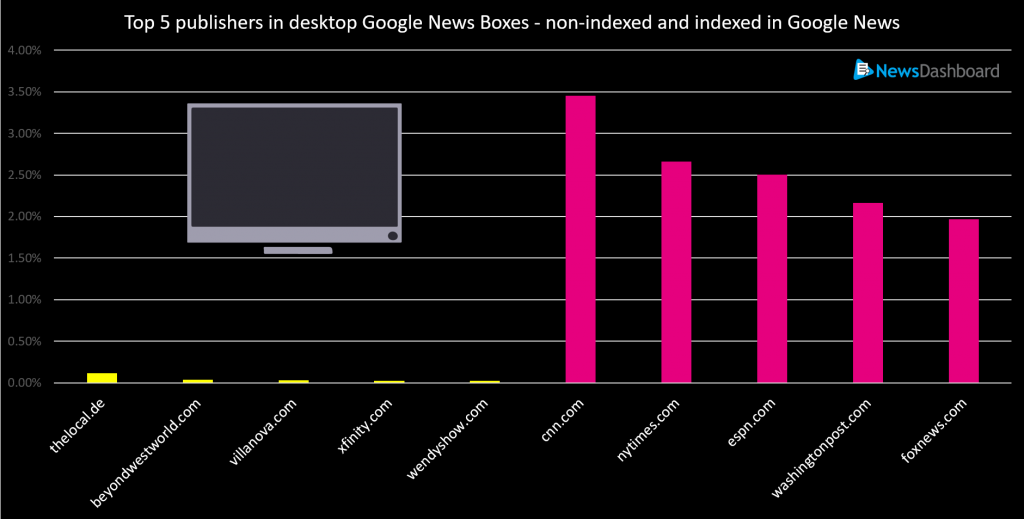
In mobile, there are slightly more non-news sites being included, and there appears to be a really strong bias toward AMP sites there. Chelsey Heath, from News Dashboard, also reported last year that AMP-only News Carousels climbed to 90 percent in all but one country she analyzed, so having AMP versions of your pages is basically table stakes for mobile news carousel exposure at this point.
I was really happy to see some concrete data around something I knew to be true from observation: the majority of sites appearing in the Top Stories boxes are Google News sites. If you’re a Google News participant, congratulations. You should have a strategy in place to maximize your exposure here. If you’re not in Google News, you might still show up in the Top Stories box, but probably with far less frequency and consistency than Google News publishers.
What Google News Traffic Looks Like In Google Analytics
Here’s an example from Google Analytics that illustrates the typical pattern I see when an article gets good exposure in a Top Stories box. This is from the report at Acquisition >> Channels >> Organic Search, with a specific article selected:

Not bad. This article was published just before 11 p.m. ET on January 27, and immediately gained exposure in a Top Stories box (verified manually), generating nearly 3,000 Google visits before midnight. It remained in the Top Stories box throughout the night and for much of the next morning, generating nearly 20,000 visits from Google in the first 12 hours after it was published. In less than 30 hours after publishing, search traffic trailed off to zero.
Want to know how many referrals were recorded from Google News for this same article? Six. Here’s the chart in all its glory:

As you can see, direct referrals from Google News were negligible in this case, but exposure in Top Stories was substantial. To say that Google News is irrelevant here is to misunderstand the source of this traffic.
How to Track “Google News” Traffic
There’s no easy solution for tracking the total traffic you get from Google via the Top Stories boxes, but recognizing the pattern above (the spike of Google traffic immediately after you publish) as Google News traffic can go a long way toward providing valuable insight to editorial teams.
Hunting through your analytics data to find the pattern I’ve shown above is a tedious process, plus you’re usually doing it after the fact. The real-time reporting in Google Analytics might help with this analysis even more by giving you an idea of where your Google traffic is coming from at any given moment.
To view real-time Google traffic, go to Real-Time >> Traffic Sources, and click on “Organic.” It should look something like this:
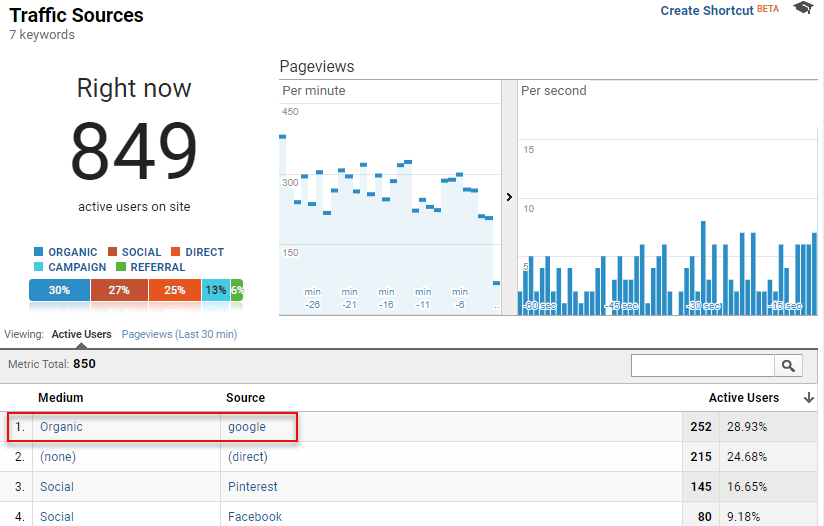
Then click on the “Content” section in the left navigation. This will produce a list of articles currently receiving “Organic” traffic:
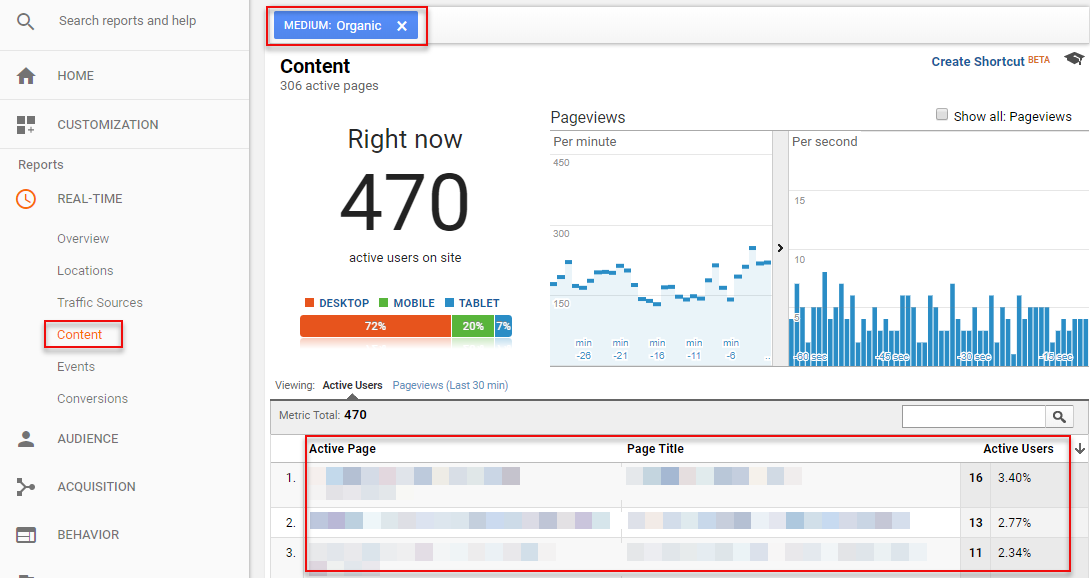
Lots of that traffic will be from older content (Google Organic), but if you recognize something that was published within the last 48 hours, there’s a really good chance it’s getting Google News exposure. Open up a browser and do a search on the most likely search term corresponding to your newly published article, and there’s a darn good chance you’ll see your article displayed in a Top Stories box.
Another tool you might find helpful is the Search Appearance filter in the Search Analytics report in Google Search Console. It looks like this:

Shortcomings of that tool are that a) Top Stories in desktop results are most likely lumped together in “Rich results,” so there’s not much visibility there b) the click data isn’t totally accurate and will not reflect the actual traffic you received from Top Stories results, and c) the data isn’t displayed in real time (important for the ephemeral Top Stories results). Your results may vary, however, so try both of the above and see what allows you to gain the most insight for your for editorial team.
At one time, I was able to track every clickable element in the news onebox using the ‘ved’ parameter, which Google passed in their referring URLs. I had it working on a couple of large sites for a while before Google changed the format of the ved’s, which killed our tracking. However, we gained a ton of valuable insight from the data collected. I’ve since not had a client with the bandwidth and resources available to allow me to geek out to this degree, but please let me know if you’re interested in working with me in this area, whether as a client or collaborator.
Channel-Specific Strategies for News and Organic
With that background, here are the two big takeaways I want to offer publishers who participate in Google News:
1. You’re probably getting way more traffic from “Google News” sources than what your analytics platform is telling you.
2. Google News and Google Organic require distinct strategies, tactics, and technical considerations. If SEO matters to your organization, then it’s critical you have channel-specific SEO strategies that align with those sources.
Hopefully this helps shed some light on why Google News is such an important source of traffic for publishers. By participating in Google News, you have a tremendous advantage over non-News sites since Top Stories boxes are given huge, instant visibility on some of the most highly searched queries. But it’s important to understand that the majority of your traffic as a Google News participant will not be generated via referrals from news.google.com (or news.url.google.com). With an effective Google News SEO strategy in place, the difficult-to-track Top Stories boxes are where the lion’s share of your Google News traffic will come from.
In my next post, I’m going to step through the top ranking factors for Google News and the Top Stories boxes. Sign up for my email list if you’d like to be notified when that goes live.

Would still love to see part two of this post 🙂
Haha…a case of the cobbler’s children having no shoes. I actually do have something in the works. Hope to get it published by December!